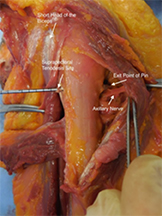Evaluation of the Anatomical Safety of Sub Pectoral Biceps Tenodesis

The biceps tendon is frequently a source of pain for patients. At the time of surgery, there are many options on how to fix the biceps tendon. Sometimes we can just trim it, sometimes we can cut it and sometimes we have to repair it back down to bone. The most popular techniques fix it through a tiny incision in the armpit. We studied the variations of this technique in order to make safety recommendations for ourselves and other surgeons.
The purpose of this study was to use a cadaveric model to define the anatomic relationships of the suprapectoral and subpectoral tenodesis sites with respect to the axillary, radial, and musculocutaneous nerves. These relationships were evaluated in three separate scenarios: an open suprapectoral tenodesis location, a perpendicularly drilled subpectoral tenodesis, and a subpectoral tenodesis with the drill aimed 30º cephalad. Our hypothesis is that penetration of the posterior humeral cortex may put neurologic structures at risk, particularly as the tenodesis site moves more proximally from the subpectoral to the suprapectoral location.







